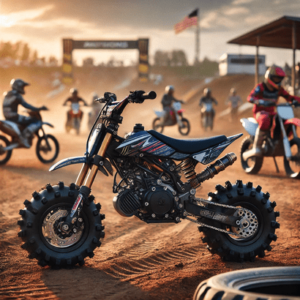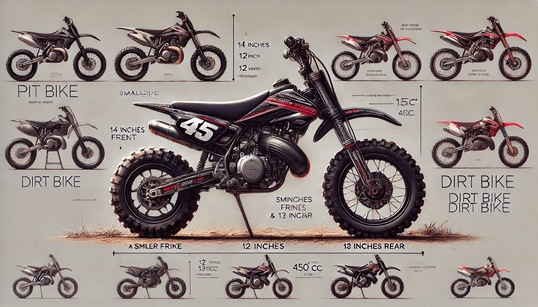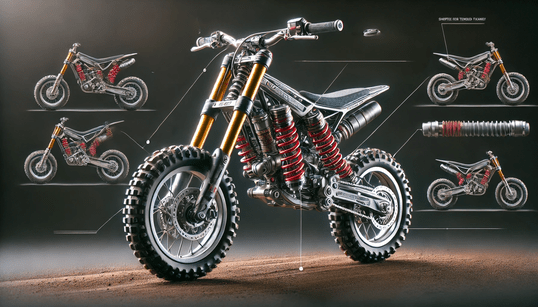In the world of off-road biking, enthusiasts often come across various types of motorcycles designed for different purposes. Two popular options that frequently spark confusion are pit bikes and dirt bikes. Whether you’re a seasoned rider or just stepping into the bike world, understanding the distinctions between these two types of off-road motorcycles is crucial. This comprehensive guide will delve into the specifics of pit bikes, explore how they differ from dirt bikes, and help you make an informed decision about which type of bike might be right for you.
What Is a Pit Bike?
A pit bike is a small motorcycle originally designed for navigating crowded pit areas at motorcycle races. These lightweight motorcycles typically feature engine sizes ranging from 50cc to 150cc, making them significantly smaller than full-sized dirt bikes. While they were initially created as a convenient way to get around race tracks, pit bikes have evolved into a popular category of their own for both recreational riding and competitive events.

The Evolution of Pit Bikes
Pit bikes have been around for a long time, but their popularity has surged in recent years. Originally, they were simple, no-frills machines used by mechanics and riders to navigate crowded pit areas during races. However, as interest grew, manufacturers began producing more advanced models designed specifically for recreational use and even competitive racing.
Today, you can find a wide range of pit bikes, from basic models perfect for beginners to high-performance machines capable of stunt riding and competitive racing. Brands like Thumpstar have become well-known in the pit bike market, offering a variety of models to suit different riders’ needs.
Key Features of Pit Bikes
Pit bikes are characterized by several distinct features:
- Small size: Pit bikes are small compared to full-sized motorcycles, making them easier to maneuver and transport.
- Lightweight construction: Their compact frames and components make them extremely light, typically weighing between 100-200 pounds.
- Small engines: Most pit bikes have engine sizes ranging from 50cc to 150cc, with both two-stroke and four-stroke options available.
- Low seat height: The low seat height makes them accessible to riders of all sizes, including younger enthusiasts.
- Basic suspension: While not as advanced as dirt bikes, pit bikes usually have adequate suspension for their intended use.
How Does a Pit Bike Differ from a Dirt Bike?
While pit bikes and dirt bikes may seem similar at first glance, several key differences set them apart. Understanding these distinctions is crucial when deciding which type of bike is right for your needs.

Size and Weight
One of the most noticeable differences between a pit bike and a dirt bike is their size. Pit bikes are significantly smaller and lighter than their dirt bike counterparts. This makes them more maneuverable in tight spaces and easier to transport, but it also means they’re less stable at high speeds and on rough terrain.
| Feature | Pit Bike | Dirt Bike |
|---|---|---|
| Weight | 100-200 lbs | 200-250 lbs |
| Seat Height | 25-30 inches | 35-40 inches |
| Wheel Size | 10-14 inches | 18-21 inches |
Engine Size and Power
Pit bikes generally have smaller engines compared to dirt bikes. While pit bike engines typically range from 50cc to 150cc, dirt bikes can have engines up to 450cc or even larger. This difference in engine size translates to a significant disparity in power output.
- Pit Bikes: Usually 50cc to 150cc
- Dirt Bikes: Commonly 125cc to 450cc
The smaller engines of pit bikes make them more approachable for beginners and younger riders, but they lack the power needed for serious off-road adventures or motocross racing.
Suspension and Handling
When it comes to suspension, dirt bikes have a clear advantage. Dirt bikes are equipped with advanced suspension systems designed to handle rough terrain and high-impact jumps. In contrast, pit bikes usually have simpler suspension setups that are adequate for smoother surfaces but may struggle in more challenging off-road conditions.
Dirt bikes typically feature:
- Long-travel forks (9-12 inches)
- High-performance rear shocks
- Adjustable compression and rebound settings
Pit bikes, on the other hand, often have:
- Shorter travel forks (4-7 inches)
- Basic rear shocks
- Limited or no adjustability
This difference in suspension quality means that dirt bikes are better suited for tackling challenging off-road trails and performing jumps, while pit bikes are more at home on smoother surfaces and in controlled environments.
Intended Use
Perhaps the most significant difference between pit bikes and dirt bikes lies in their intended use:
- Pit Bikes: Originally designed for navigating pit areas, now used primarily for recreational purposes, beginner training, and some competitive events.
- Dirt Bikes: Built for serious off-road riding, motocross racing, and enduro competitions.
While both types of bikes can be used for fun and recreation, dirt bikes are better equipped to handle the demands of aggressive off-road riding and competitive racing.
Are Pit Bikes Street Legal?
One common question that arises when discussing pit bikes and dirt bikes is whether they can be used on public roads. In most cases, pit bikes are not street-legal, and the same is true for many dirt bikes. There are several reasons for this:
- Lack of necessary equipment: Pit bikes and many dirt bikes lack the required safety features for road use, such as headlights, turn signals, and mirrors.
- Emissions standards: Many off-road motorcycles don’t meet the emissions standards required for street-legal vehicles.
- Registration and licensing: Pit bikes are often not eligible for registration as road-going vehicles.
It’s important to note that regulations can vary by location, so it’s always best to check your local laws regarding the use of off-road motorcycles on public roads. Some dirt bikes can be modified to become street legal, but this is less common with pit bikes due to their smaller size and limited power output.
What Makes the Suspension System of Pit Bikes Unique?
While we’ve touched on the differences in suspension between pit bikes and dirt bikes, it’s worth exploring the unique aspects of pit bike suspension in more detail.
Simplified Design
Pit bikes typically feature a simplified suspension system compared to their larger dirt bike counterparts. This design choice is influenced by several factors:
- Intended use: Since pit bikes are primarily used on smoother surfaces and for recreational purposes, they don’t require the same level of suspension performance as dirt bikes.
- Cost considerations: Simplified suspension systems help keep the overall cost of pit bikes lower, making them more accessible to a wider range of riders.
- Weight reduction: Less complex suspension components contribute to the lightweight nature of pit bikes.
Adequate for Most Riders
While the suspension on pit bikes may not be as advanced as that found on dirt bikes, it’s generally adequate for the majority of pit bike riders. The suspension system on a typical pit bike includes:
- Front forks with 4-7 inches of travel
- A basic rear shock absorber
- Limited or no adjustability options
This setup provides enough cushioning and control for riding on relatively smooth surfaces, performing small jumps, and navigating mild obstacles. However, it may struggle with more challenging rough terrain or aggressive riding styles.
Customization Options
For riders looking to improve their pit bike’s performance, there are often aftermarket suspension upgrades available. These can include:
- Upgraded fork internals for better damping
- Adjustable rear shocks
- Stiffer springs for heavier riders or more aggressive riding styles
While these upgrades can enhance the performance of a pit bike, it’s important to remember that they won’t transform it into a full-fledged dirt bike. The inherent limitations of the pit bike’s frame and geometry will still play a role in its overall capabilities.

Conclusion: Choosing Between a Pit Bike and a Dirt Bike
When deciding between a pit bike and a dirt bike, it’s essential to consider your specific needs, riding experience, and intended use. Here’s a quick summary to help you make an informed decision:
Choose a Pit Bike if:
- You’re new to off-road riding and want a less intimidating starting point
- You’re looking for a fun, recreational bike for casual riding
- You need a compact, lightweight bike that’s easy to transport
- You’re on a tighter budget
Choose a Dirt Bike if:
- You’re an experienced rider looking for high-performance off-road capabilities
- You plan to participate in motocross racing or serious trail riding
- You need a bike that can handle challenging rough terrain and big jumps
- You’re willing to invest more in a more capable and versatile machine
Regardless of which type of bike you choose, always prioritize safety by wearing appropriate protective gear and following local regulations. Whether you’re zipping around on a pit bike or tackling tough trails on a dirt bike, the world of off-road motorcycles offers endless opportunities for excitement and adventure.
